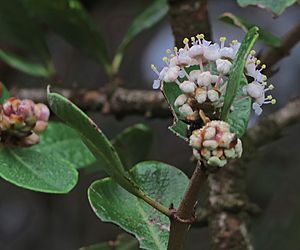Ceanothus ferrisiae facts for kids
Quick facts for kids Ceanothus ferrisiae |
|
|---|---|
 |
|
| Conservation status | |
| Scientific classification | |
| Genus: |
Ceanothus
|
| Species: |
ferrisiae
|
Ceanothus ferrisiae (say: see-uh-NO-thus FAIR-iss-ee-ay), also known as coyote ceanothus, is a very rare type of shrub. It belongs to the Rhamnaceae family, which includes many flowering plants. This special plant is found in only a few places in California. It is considered an endangered species, meaning it is at risk of disappearing forever.
What Does It Look Like?
Ceanothus ferrisiae is a shrub that can grow quite tall, sometimes reaching almost two meters (about 6.5 feet). Its woody branches start out reddish and then turn gray as they get older.
Its leaves are always green, meaning they don't fall off in winter. They grow in pairs on opposite sides of the stem and are about 3 centimeters (just over an inch) long. The leaves feel firm and flat, and they often have small teeth along their edges. The top side of a leaf is smooth and dark green, while the underside is lighter and feels a bit fuzzy.
In winter, this plant grows small clusters of white flowers. After the flowers, it produces a rough, horned fruit that is just under a centimeter wide.
Where Does It Live?
Ceanothus ferrisiae is found only in Santa Clara County, California. This means it is endemic to that area. It grows in only about four or five spots near Mt. Hamilton in the Diablo Range.
This plant prefers to grow in a special type of ground called serpentine soil. It is also found in areas with chaparral, which is a type of shrubland with tough, woody plants.
One of the biggest groups of these plants, located near Anderson Dam, was badly affected by a wildfire in 1992. That fire destroyed about 95% of the plants there. Luckily, the population is slowly growing back. Because it is so rare and at risk, the United States government has listed it as an endangered species.
Why Is It Endangered?
Today, there are only about 6,000 individual Ceanothus ferrisiae plants left in the world, spread across five main locations. The biggest danger to this plant is that its habitat (the place where it lives) is being lost or damaged. This happens when land is cleared for new buildings or other uses.
Another challenge for the coyote ceanothus is that new plants don't seem to grow very easily. This makes it harder for the population to increase naturally. Protecting its habitat is very important to help this unique plant survive.


